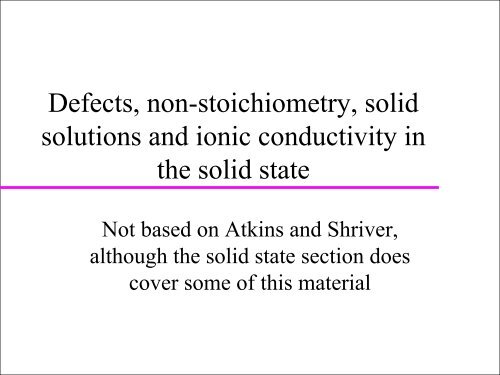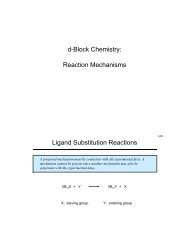Defects, non-stoichiometry, solid solutions and ionic conductivity in ...
Defects, non-stoichiometry, solid solutions and ionic conductivity in ...
Defects, non-stoichiometry, solid solutions and ionic conductivity in ...
Create successful ePaper yourself
Turn your PDF publications into a flip-book with our unique Google optimized e-Paper software.
<strong>Defects</strong>, <strong>non</strong>-<strong>stoichiometry</strong>, <strong>solid</strong><strong>solutions</strong> <strong>and</strong> <strong>ionic</strong> <strong>conductivity</strong> <strong>in</strong>the <strong>solid</strong> stateNot based on Atk<strong>in</strong>s <strong>and</strong> Shriver,although the <strong>solid</strong> state section doescover some of this material
<strong>Defects</strong> <strong>in</strong> crystals• It is not possible to make crystals that are perfect <strong>in</strong>every respect– some are more perfect than others• It takes energy to create defects <strong>in</strong> crystals• The presence of defects <strong>in</strong>creases the entropy of thecrystal– above absolute zero always expect some <strong>in</strong>tr<strong>in</strong>sic defects
Non-stoichiometric compoundsTiO x “TiO” 0.65 < x < 1.25“TiO 2 ” 1.998 < x < 2.000VO x “VO” 0.79 < x < 1.29Mn x O “MnO” 0.848 < x< 1.000Ni x O “NiO” 0.999 < x < 1.000Li x V 2 O 5 0.2 < x < 0.33
The thermodynamics of defect formation All macroscopic samples of materials conta<strong>in</strong> somedefects as defect formation is entropically favored– when defect formation is enthalpically very unfavorable theremay be very small numbers of defects
Types of defect• <strong>Defects</strong> may occur <strong>in</strong> isolation due to the <strong>in</strong>crease <strong>in</strong>entropy of the crystal– <strong>in</strong>tr<strong>in</strong>sic po<strong>in</strong>t defects• May occur <strong>in</strong> isolation to balance the presence of animpurity– extr<strong>in</strong>sic po<strong>in</strong>t defect• Defect may occur throughout the crystal– extended defect
Intr<strong>in</strong>sic po<strong>in</strong>t defects• Two common types of <strong>in</strong>tr<strong>in</strong>sic po<strong>in</strong>t defect– Schottky <strong>and</strong> Frenkel• A Schottky defect consists of charge balanc<strong>in</strong>g cation<strong>and</strong> anion vacancies– Found <strong>in</strong> NaCl• A Frenkel defect is a charge balanc<strong>in</strong>g <strong>in</strong>terstitial <strong>and</strong>vacancy– can have cation or anion Frenkel defects
Schottky <strong>and</strong> Frenkel defectsShottky defect <strong>in</strong> NaCl- both cation <strong>and</strong> anion are miss<strong>in</strong>g fromtheir regular lattice sites-at room temp on 1 <strong>in</strong> 10 15 sites are vacant <strong>in</strong> NaCl-200 kJmol -1 creation energyCation Frenkel defect <strong>in</strong> AgCl-cation is displaced from regular latticesite onto <strong>in</strong>terstitial site- 130 kJ mol -1 creation energy
Frenkel defects• Frenkel defects may occur on either the anionor cation sublattice• Cation Frenkel defects are more common thananion defects– cations are smaller than anions <strong>and</strong> hence easier toaccommodate <strong>in</strong> <strong>in</strong>terstitial positions• Fluorite structures (CaF 2 , SrF 2 , ZrO 2 , UO 2 ) aregood at accommodat<strong>in</strong>g anion Frenkel defects
∆H f for defects
Imag<strong>in</strong>g plates• Color centers are useful <strong>in</strong> medical X-raysus<strong>in</strong>g BaFBr:Eu 2+ phosphors
BaFBr:Eu 2+ phosphors
Extr<strong>in</strong>sic po<strong>in</strong>t defects• If cat<strong>ionic</strong> impurities are <strong>in</strong>troduced <strong>in</strong>to a <strong>solid</strong> <strong>and</strong> thedopant does not have the same valence as the cation it isreplac<strong>in</strong>g extr<strong>in</strong>sic defects will be <strong>in</strong>troduced–Fe 1-x O has cation vacancies–Ca 2+ <strong>in</strong> ZrO 2 - anion vacancies–Y 3+ <strong>in</strong> ZrO 2 - anion vacancies–Ca 2+ or Cd 2+ <strong>in</strong> NaCl- cation vacancies• Real crystals conta<strong>in</strong> both <strong>in</strong>tr<strong>in</strong>sic <strong>and</strong> extr<strong>in</strong>sic defects– the dom<strong>in</strong>ant defect type depends upon temperature <strong>and</strong>dop<strong>in</strong>g/<strong>non</strong><strong>stoichiometry</strong> level
Nonstoichiometric 3d oxides
FeO• Wustite is a very well studied example of a<strong>non</strong>stoichiometric compound• The compound “FeO” is not stable• The <strong>stoichiometry</strong> is always Fe 1-x O
The iron oxygen phase diagram
The nature of the defects <strong>in</strong> “FeO”• Density measurements confirm that the<strong>non</strong><strong>stoichiometry</strong> is <strong>in</strong>corporated by hav<strong>in</strong>g vacantiron sites• There is Fe(III) present to charge compensate thesystem
The defect structure of “FeO”• The defect structure is more complicated thanr<strong>and</strong>om iron vacancies <strong>and</strong> Fe(III)
Koch clusters <strong>in</strong> Fe 1-x O
The Fluorite structure
Defect clusters <strong>in</strong> UO 2+x Excess oxygen is<strong>in</strong>corporated <strong>in</strong> <strong>in</strong>terstitialsites– This leads to displacementof oxygens from normalsites– Arrangement of defects issimilar to structure of U 4 O 9» Can view defects as form<strong>in</strong>gclusters of U 4 O 9 <strong>in</strong> UO 2matrix
Substitutional <strong>solid</strong> <strong>solutions</strong> In many compounds it is possible to replace a metalatom or ion with another element that has similar size<strong>and</strong> bond<strong>in</strong>g requirements– In metal alloy can replace metal atom with another elementthat is with<strong>in</strong> 15% size– Can get complete <strong>solid</strong> solution formation between Al 2 O 3<strong>and</strong> Cr 2 O 3 –Al 2-x Cr x O 3– Extensive <strong>solid</strong> solution formation is favored by hightemperatures due to the disorder associated with the <strong>solid</strong>solution
Criteria for <strong>solid</strong> solution formation Typically, for an <strong>ionic</strong> <strong>solid</strong> the ion size differenceshould be less than 15-20% to get complete <strong>solid</strong>solution formation– > 30% size difference usually precludes <strong>solid</strong> solutionformation End member of <strong>solid</strong> solution should have samestructure if complete <strong>solid</strong> <strong>solutions</strong> is to form–Zn 2 SiO 4 <strong>and</strong> Mg 2 SiO 4 have different metal coord<strong>in</strong>ation»So Zn 2-x Mg x SiO 4 <strong>and</strong> Mg 2-x Zn x SiO 4 have different structures
Interstitial <strong>solid</strong> <strong>solutions</strong>Some <strong>solid</strong> <strong>solutions</strong> <strong>in</strong>volve <strong>in</strong>sert<strong>in</strong>g atoms<strong>in</strong>to <strong>in</strong>terstitial sites <strong>in</strong> a parent structure–PdH x 0 < x < 0.7 - hydrogen occupies <strong>in</strong>terstitialsites <strong>in</strong> fcc Pd– Carbon <strong>in</strong> <strong>in</strong>terstitial sites of fcc Fe
Aliovalent substitution If you replace an ion by one with a different oxidationstate (aliovalent substitution) there has to be a chargecompensation mechanism Cation vacancies– Dope calcium <strong>in</strong>to NaCl – Na 1-2x Ca x V x Cl– Replacement of Mg 2+ by Al 3+ <strong>in</strong> sp<strong>in</strong>el»[Mg 1-3x V x Al 2x ] tet [Al 2 ] oct O 4– Oxidation of NiO»Ni 2+ 1-3xV x Ni 3+ 2xO
Aliovalent substitution Interstitial anions– Not common due to limited size of <strong>in</strong>terstitial sites butoccurs for fluorite structure»Ca 1-x Y x F 2+x»U 4+ 1-xU 6+ xO 2+x Anion vacancies– Important <strong>in</strong> <strong>ionic</strong> conductors»Zr 1-x Ca x O 2-x 0.1 < x < 0.2 Interstitial cations–Li x (Si 1-x Al x )O 2 stuffed quartz structure (0 < x < 0.5)
Characteriz<strong>in</strong>g <strong>solid</strong> <strong>solutions</strong>Can determ<strong>in</strong>e if <strong>solid</strong> solution forms bymeasur<strong>in</strong>g lattice constants of material us<strong>in</strong>gx-ray diffraction– Lattice constants typically vary l<strong>in</strong>early with <strong>solid</strong>solution composition» Vegard’s lawCan work our mechanism of <strong>solid</strong> solutionformation with the aid of densitydeterm<strong>in</strong>ation
Ionic conductors• Ionic <strong>solid</strong>s conta<strong>in</strong> defects that allow the migration ofions <strong>in</strong> an electric field• Some <strong>solid</strong> materials have very high <strong>ionic</strong>conductivities at reasonable temperatures– useful <strong>in</strong> <strong>solid</strong> state devicesmobile vacancymobile <strong>in</strong>terstitial
Applications of <strong>solid</strong> <strong>ionic</strong> conductors• Membranes <strong>in</strong> separation processes• Electrolytes <strong>in</strong> sensors• Electrolytes <strong>in</strong> fuel cells <strong>and</strong> batteries– should be a poor electronic conductor• Electrode materials <strong>in</strong> <strong>solid</strong> state batteries– should be a good electronic <strong>and</strong> <strong>ionic</strong>conductor
Factors effect<strong>in</strong>g the <strong>conductivity</strong>• σ = n Z e µ• Conductivity is <strong>in</strong>fluenced by 1)the carrier concentration n,2) the carrier mobility µ• Usually, defects act as the charge carriers– not many defects <strong>in</strong> most <strong>ionic</strong> <strong>solid</strong>s– mobility is usually low at room temperatureIonic conductorsElectronic conductorsMaterialIonic crystalsSolid ElectrolytesLiquid electrolytesMetalsSemiconductorsInsulatorsConductivity (S m -1 )< 10 -16 –10 -210 -1 -10 310 -1 -10 310 3 -10 710 -3 -10 4< 10 -10
Ionic <strong>conductivity</strong> <strong>in</strong> NaCl• NaCl is a poor <strong>ionic</strong>conductor• Conduction <strong>in</strong>volvesmigration of cationvacancies• Cation vacancies arepresent due to– dop<strong>in</strong>g - extr<strong>in</strong>sic defects– Schottky defects - <strong>in</strong>tr<strong>in</strong>sicdefects
Conduction is an activated process• µ = µ 0 exp (-Ea/kT) - Arrhenius equation
Temperature dependence of <strong>conductivity</strong>• σ = (σ 0 /T) exp(-Ea/kT)– Contribution from mobility <strong>and</strong> defect formation
Idealized <strong>conductivity</strong> for NaClAt low T, <strong>conductivity</strong> isdom<strong>in</strong>ated by mobility ofextr<strong>in</strong>sic defectsAt High T, <strong>conductivity</strong> isdue to thermally formed(<strong>in</strong>tr<strong>in</strong>sic) defects
Intr<strong>in</strong>sic versus extr<strong>in</strong>sic <strong>conductivity</strong>• Extr<strong>in</strong>sic <strong>conductivity</strong>– σ = (σ 0 /T) exp(-E a /kT)– carrier concentration is fixed by dop<strong>in</strong>g• Intr<strong>in</strong>sic <strong>conductivity</strong>– carrier concentration varies with temperature– σ = (σ’ 0 /T) exp(-E a /kT) exp(-∆H S /2kT)– slope of plot gives E a + ∆H S /2
Experimental <strong>conductivity</strong> of NaClBroadly as expected– Get deviation at low T dueto vacancy pair<strong>in</strong>g– Get deviation at high T dueto screen<strong>in</strong>g of mobiledefects by defects ofopposite charge» Debye-Huckle type model
Energetics of <strong>ionic</strong> conduction <strong>in</strong> NaClProcessActivation energy (eV)Migrationof Na + , E m0.65-0.85Migration of Cl - 0.90-1.10Formation of Schottky pairDissociation of vacancy pairDissociation of vacancy –Mn 2+ pair2.18-2.38~1.30.27-0.50
AgCl• The predom<strong>in</strong>ant defect <strong>in</strong> AgCl is cationFrenkel• Cation <strong>in</strong>terstitials are more mobile than cationvacancies• Cation <strong>in</strong>terstitials can migrate by one of twomechanisms– direct movement– <strong>in</strong>direct movement
Migration mechanism <strong>in</strong> AgClTwo possible pathways for <strong>in</strong>terstitial migration:1) move directly from <strong>in</strong>terstitial to <strong>in</strong>terstitial2) <strong>in</strong>terstitial displaces regular cation onto<strong>in</strong>terstitial positionMigration actually occurs by second pathway
Evidence for the <strong>in</strong>direct mechanism• Both charge <strong>and</strong> mass transport through a crystalcan be measured– <strong>conductivity</strong> gives charge mobility– diffusion measurements us<strong>in</strong>g radiolabelled Ag + givesmobility of Ag +• Charge is transported twice as fast as Ag + ionssuggest<strong>in</strong>g the <strong>in</strong>direct mechanism is correct
Solid electrolytes• There is a technological need for <strong>solid</strong>s that havevery high <strong>ionic</strong> conductivities• Such materials are referred to as FAST IONCONDUCTORS• They <strong>in</strong>clude:– α AgI–Na β alum<strong>in</strong>a– NASICON, Na 1+x Zr 2 [(PO 4 ) 3-x (SiO 4 ) x ]– Stabilized zirconias
Ionic <strong>conductivity</strong> of some good <strong>solid</strong> electrolytes
β - alum<strong>in</strong>a• Na 1+x Al 11 O 17+x/2 (β) <strong>and</strong> Na 1+x Mg x Al 11-x O 17 (β”) aregood sodium ion conductors at moderate temperatures• Na ions have high mobility <strong>and</strong> can be ion exchangedwith a wide variety of other cations• M 2 O.x Al 2 O 3 x = 5 - 11– M = Alkali + , Cu + , Ag + , Ga + , In + , Tl + , NH 4+– x = 5-7 usually produces β” material– x = 8 - 11 gives β material– β” material usually stabilized by addition of Li + or Mg 2+
The structures of β <strong>and</strong> β” alum<strong>in</strong>a
The sodium sulfur cell• Sodium sulfur cells have ahigh energy density– useful for electric vehicles• There are safety concerns– molten sodium• 2Na (l) 2Na + + 2e -• 2Na + + 5S (l) + 2e - Na 2 S 5(l)
Silver iodide• At low temperatures AgI adopts either a Wurtzite orz<strong>in</strong>c blende structure–Ag + fills half of the tetrahedral holes <strong>in</strong> a close packed I -array• Above 146 o C it transforms to a BCC structure withthe Ag + fill<strong>in</strong>g a small fraction of the availabletetrahedral sites– the cation sublattice “melts”σ~ 130 Sm -1
The structure of α -AgI
Cation sites <strong>in</strong> α -AgI
Ionic conduction <strong>in</strong> α - AgI• There are many possible sites for Ag+– 12 tetrahedral– 24 trigonal– 6 octahedral• There are only 2 Ag + ions per unit cell!– these ions are found disordered on the tetrahedral sites• Motion between sites is facile– ~0.05 eV activation barrier
RbAg 4 I 5• AgI is polymorphic. The hightemperature α phase has ahigh <strong>ionic</strong> <strong>conductivity</strong>associated with a melted Ag +sublattice• At low T <strong>ionic</strong> <strong>conductivity</strong>drops• RbAg 4 I 5 discovered whiletry<strong>in</strong>g to f<strong>in</strong>d materials that stillhad α – AgI structure at low T
RbAg 4 I 5 Highest room temperature <strong>ionic</strong> <strong>conductivity</strong> ofany crystall<strong>in</strong>e <strong>solid</strong>, 0.25 S cm -1– Not stable < ~25 °C
Stabilized zirconias• Y 2 O 3 <strong>and</strong> CaO can bedissolved <strong>in</strong> ZrO 2– creates a lot of oxygenvacancies• At high temperaturesthe defects are mobile– oxide ion conductor
Applications of stabilized zirconia• Oxide conductors are of use for– oxygen sensors» based on concentration cell, can be used to measure O 2 <strong>in</strong>exhaust gases, molten metals …– fuel cell membranes• ZrO 2 is only usable at high temperatures
An oxygen sensor• An O 2 concentration cell can be built• E = [2.303RT/4F] log(p’/p ref )
Fuel cellsFuel cells aredevices for thedirect conversionof fuels such asCH 3 OH, H 2 , CO toelectrical energy
Solid oxide fuel cells• Fuel cells offer anefficient <strong>and</strong> cleanway of us<strong>in</strong>g fossilfuels, but– high cost– thermal cycl<strong>in</strong>gproblems
Electrochromic devicesColor changes suchas those needed <strong>in</strong>smart w<strong>in</strong>dows canbe achieved bymov<strong>in</strong>g ions <strong>in</strong>to asuitable <strong>solid</strong>
Lithium batteriesBatteries based onlithium are attractiveas they can be light ahave a very highvoltage output– Considerable currentresearch on cathodes<strong>and</strong> electrolytes forthese devices











